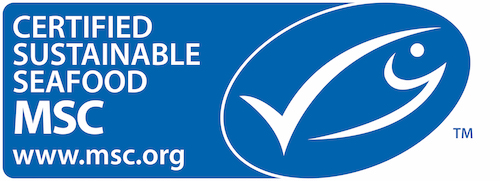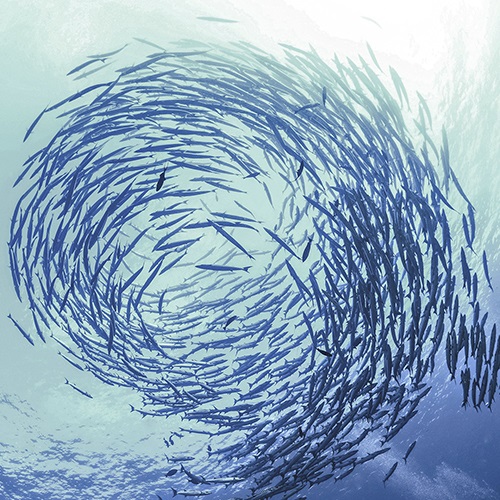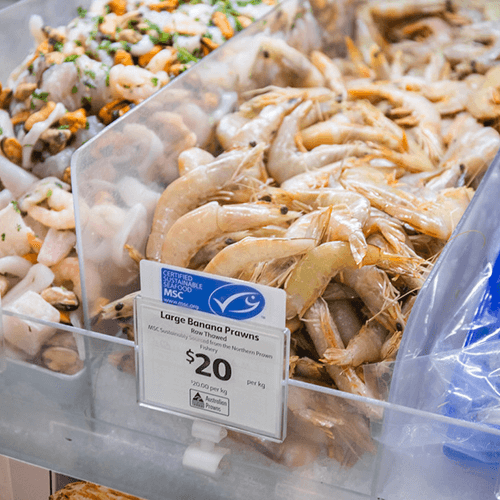When you choose wild-caught seafood with the MSC blue fish tick label, you’re choosing a future full of fish. The blue fish tick label from the Marine Stewardship Council indicates certified sustainable seafood from healthy, wild fish populations.

Making sure there’s enough fish in the sea for the next generation
A third of wild fish populations globally are overfished. Overfishing means we’re not always leaving enough fish for our children and grandchildren.
Fish need time to grow and re-produce and sustainable fishing allow this to happen.
To be certified as sustainable, teams of marine scientists look at a fishery to assess if fish is being caught at the right level and in the right way. Fisheries that opt into this process, can get independently certified as sustainable to the MSC Fisheries Standard. This process typically takes 12-18 months and is scrutinised by a range of stakeholders, with certificates lasting up to 5 years.
Often fisheries are required to make continual improvements to gain and maintain certification. If improvements are not met, fisheries can lose their certificate. Improvements can include measures to minimise bycatch such as marine mammals and birds and to adapt to the effects of climate change on our ocean.
Sustainable fishing to the MSC Fisheries Standard means:
- Healthy populations of fish
- Impacts on ecosystems minimised
- Responsible and effective management
Learn more about the work of the Marine Stewardship Council including how the certification process works in this Ocean Protect podcast featuring our resident scientist and shark expert Dr Adrian Gutteridge.
Choosing sustainable seafood is easy
Wild-caught seafood with the blue fish tick can be traced back to a certified sustainable fishery. We conduct DNA testing to ensure this works, so you can be sure the fish you're buying is what it says it is. There are many sustainable fish species to eat. Whether it's an everyday purchase or for a special occasion such as for Good Friday and over Easter or prawns at Christmas, you can purchase sustainable seafood with the blue fish tick at supermarkets in Australia and New Zealand.
Where to buy sustainable seafood in Australia
Where to buy sustainable seafood in New Zealand

Find out where else to buy sustainable seafood with the blue fish tick.
Delicious sustainable seafood recipes
We’ve worked with chefs around the world to bring you this collection of feel-good sustainable seafood recipes for every taste and budget. Enjoy wild-caught seafood today, knowing there’ll be enough in the future for your children and grandchildren to enjoy too. Afterall, no-fin else matters!
Ingredients
Method
- 2 large potatoes, washed and cut into wedges
- 1 tbsp olive oil
- 2 tbsp porridge oats
- 1 tbsp grated Parmesan cheese
- 1 1/2 tbsp ground almonds
- 1 tsp of dried parsley
- 2 MSC labelled haddock fillets, skin removed
- 200g frozen peas
- Knob of butter
- 1/2 tsp of dried mint
- 1 lemon
- Salt and black pepper
- Preheat the oven to 180°C/350°F/gas 4.
- Add the potato wedges to a saucepan of boiling water and parboil for 6-8 minutes. Drain and leave to dry for a couple of minutes. Next toss them in a tablespoon of olive oil and a pinch of salt. Place on a baking tray and spread out in one layer. Bake for 30 minutes, turning once, until golden brown.
- Meanwhile, place the porridge oats, grated cheese, ground almonds, and dried parsley in a shallow bowl. Add a pinch of salt and black pepper. Mix to combine. Dip the haddock fillets into the crumb mixture and place on a lined baking tray. Spoon any additional crumb on top before baking for 15 minutes in the oven.
- Cover the peas with water in a shallow pan and place on a medium to high heat. Bring the water to a boil, cover the pan, and allow the peas to simmer for 3 minutes. Drain the peas and transfer to a bowl Add the butter and mint and mash with a potato masher and season to taste.
- Divide the potato wedges, and mushy peas between 2 plates. Add a fish fillet to each and a wedge of lemon. Serve immediately – with or without a dollop of ketchup or mayo!

Sustainability Q&A with Dr Hazel
When and how did sustainability first become important to you?
I became more conscious of where I was sourcing my food about 2 years ago. I initially thought the only way I could support the oceans was cutting out fish and seafood completely but after educating myself - and after interviewing Lucy Erickson, former Science Communications Manager for the Marine Stewardship Council - I learned more about how we can support sustainable seafood practices, whilst keeping it in our diet.
What’s your favourite sustainable fish dish?
My homemade fish and chips! it reminds me of home and it's a very versatile dish which can be used with any white fish or salmon.
The Food Medic is an educational platform and media group whose aim is to bridge the gap between traditional medical advice and the latest thoughts and developments in nutrition and other areas of lifestyle. Listen to Dr Hazel's interview with MSC's former Science Communications Manager, Lucy Erickson, on Season 2 episode 8 of her podcast, as they discuss sustainable seafood.

 The MSC blue fish ecolabel means that your seafood is certified as sustainable as traceable, so future generations can enjoy the seafood we love.
The MSC blue fish ecolabel means that your seafood is certified as sustainable as traceable, so future generations can enjoy the seafood we love.
What is MSC? We are science-based charity working with fisheries, retailers, restaurants and you, the consumer, to recognise and reward sustainable fishing.
Find out more

What is sustainable fishing?
Sustainable fishing means leaving enough fish in the ocean, respecting habitats and ensuring people who depend on fishing can maintain their livelihoods.

Is seafood with the blue fish tick really sustainable?
You can trust that seafood with the blue fish tick was caught by a responsible fishery in a sustainable way.

How does the MSC label compare?
There are many labels out there, so how does the blue fish compare with others?




.png?sfvrsn=a61dc5da_0&MaxWidth=700&MaxHeight=&ScaleUp=false&Quality=High&Method=ResizeFitToAreaArguments&Signature=32E0D61A3C57BC1FCA249CA196754D9E3A662020)